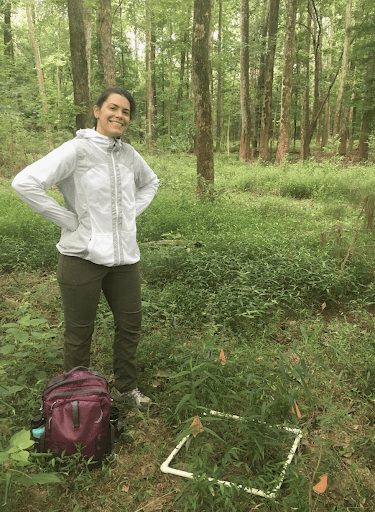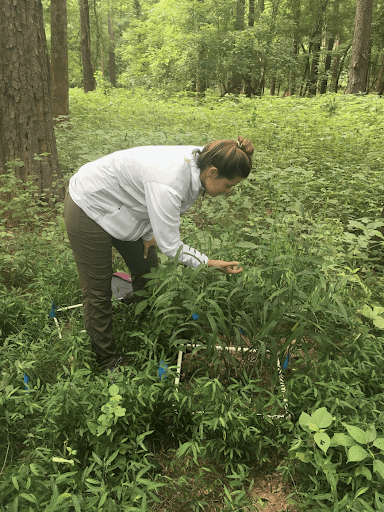What happens when research scientists and conservation practitioners work together to restore Georgia’s floodplains?
Collaborative efforts led by University of Georgia graduate students and conservation practitioners at the State Botanical Garden of Georgia show how vital partnerships are in restoring the floodplains of Georgia. Linsey Haram and Rachel Smith, PhD graduates from the Odum School of Ecology, began their floodplain restoration research project in 2017 in collaboration with Heather Alley, a conservation horticulturist with the State Botanical Garden, a unit of Public Service and Outreach at UGA. For three years they, along with Odum School undergraduates Diane Klement and Hannah Mone, conducted experiments to determine the most effective methods of removing invasive plants. They recently published their findings in Restoration Ecology.
“Emphasizing the value of academic and nonprofit partnerships for this type of work is super important,” said Haram. She explained that bridging the gap between researchers and practitioners can lead to strides in conservation practices; the floodplain restoration project conducted by the UGA partnerships certainly reaped the benefits of this collaborative effort.
Alley has dedicated years to restoring the floodplain bordering the Middle Oconee River and has worked to rid this area of invasive species, organisms that are not native to an environment and whose introduction causes harm to the ecosystem they colonize. For many ecosystems, such as floodplains, invasive species pose a threat to biodiversity, compete for resources with native plants and animals, and damage the overall health of the environment. Restoring floodplains to their natural state is a challenge, as conservationists must determine the most effective method of removing invaders, while also having the least negative impact on the delicate ecosystem they are trying to restore.
Floodplains are areas of relatively flat land that are prone to frequent flooding. Stiltgrass is a low-lying plant species native to Asia that is now widespread across much of the U.S. It forms dense stands that disrupt forest ecosystems, and has become especially problematic in flood plains. Because floodplains provide numerous services both economically and environmentally, they are an important area to protect.
The floodplain restoration project presented a unique opportunity for scientists from UGA to partner with the State Botanical Garden. Smith and Haram, with their invasive species expertise, and Alley, with her years of on-the-ground experience, worked together to design a controlled experiment to analyze what method and frequency of application were most effective for stiltgrass removal.
“It was a really great opportunity to work with the scientists at the University of Georgia to help address one of our questions with our floodplain restoration,” said Alley.
The team established ten experimental blocks to test the effectiveness of restoration methods (combinations of herbicide, native planting, and native seeding) and application frequency (single and annual) in combating the stiltgrass. The native plant of choice was river oats. Alley explained that as a cool season perennial, river oats would already be “full and robust” by the time stiltgrass began to sprout in the warmer season.
“We found that combining herbicide and native planting was the most effective way of reducing the invasive annual stiltgrass,” said Smith.
The results showed that the combination of a single application of herbicide and native planting helped reduce the mass of stiltgrass within the floodplain, while also minimizing the harm to non-targeted native plant species.

This detailed restoration project provides empirical evidence for practitioners to use in restoring floodplains from invasive species, offering an effective, data-driven methodology for stiltgrass removal.
For the State Botanical Garden, the next plan of action is to continue adding more native plants such as river oats to select areas of the floodplain to reduce the presence of persistent invasive species. These areas include visible spots open to the public, and areas that already have native plants established.
As for Smith and Haram, this restoration project was an important step in their professional journey. After graduating from UGA, these researchers have continued their work in the field of conservation. Haram is currently a Science and Technology Policy Fellow with the American Association for the Advancement of Science (AAAS) in Washington, D.C., working at the U.S. Department of Agriculture. Smith is currently working as a NatureNet Science Fellow with the University of Virginia and the Nature Conservancy’s Virginia Coast Reserve.
The findings for the floodplain restoration project were published in the October, 2021 edition of Restoration Ecology: Smith, R.S., Alley, H., Klement, D. and Haram, L.E. (2021), Academic-conservation partnership reveals trade-offs in treatment method and frequency needed to restore invaded floodplain. Restor Ecol e13597. https://doi.org/10.1111/rec.13597

